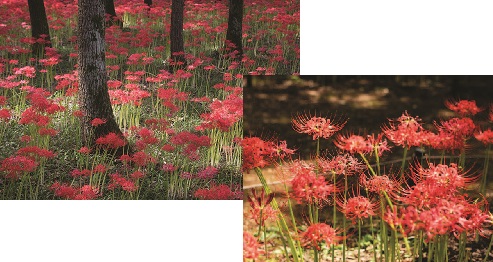By Virginia Gregory
When the brutal heat of summer is finally passing and taking the most vibrant garden colors with it, there is a bloom that shines like a Las Vegas showgirl down county roads and in a few lucky gardens. Blooming LYCORIS RADIATA glows like a siren light from a distance, but up close the frilly profusion of petals sticking up gave some sour soul the excuse to call this gorgeous firework bloom the ugly name “SPIDER LILY.” It’s almost like the common name was thought up by the plainer flowers that were bitter jealous and couldn’t stand to admit what a looker LYCORIS RADIATA really is. As a little girl, the much more apt common name stuck in my head “NAKED LADIES”— Now that is a name that captures this attention-grabbing spectacle that happens every September!
But before you get the impression that these blooms are debauched and difficult, please understand that LYCORIS RADIATA is one of the most modest plants the rest of the year. After the September pageant show is gone and forgotten, some dark green strappy leaves with a thin white stripe come out and make it through the whole winter, disappearing with the summer heat. So, plant these girls anywhere, because you are not mowing, spraying, or weed eating in the winter, and they will grow unmolested during the cool season. This plant behavior leads to the third common name “SURPRISE LILY” which captures one of the most endearing qualities of the flower. The bud jumps up seemingly overnight from bare ground with its neon curling filaments and puts on a peepshow when our gardener’s hearts need it most.
Scientist tagged the flower “LYCORIS RADIATA” indicating radial symmetry of the petals, but just plain “radiant lily” would describe her better. Other common names for this flamboyant gal describe her other properties. “Magic lily”, “equinox lily”, “hurricane lily”, “ditch lily” and “schoolyard lily” are some you might hear.
LYCORIS RADIATA and her sisters have been playing peek-a boo in our Alabama landscapes since they arrived from south Asia in the mid 1800’s with other amaryllis. If you don’t already have some, you are late to this party! Many varieties of lycoris bulbs can be had from online nurseries, but surely, it’s more fun to make friends with a generous gardener that has some to spare. The best way involves finding something in your yard to swap for lycoris bulbs so that the next time you are at dinner party you can work in the question; “Does anyone have extra naked ladies to trade?” Quickly, you can discern who you want to sit by and who you want to avoid.
I’ve moved seven times since leaving Montgomery in 1986 and planted Alabama lycoris bulbs in a half dozen gardens in other states. It’s good to think the “ladies” are putting on the show every September for new audiences. My move back home to Montgomery was a rush, so I couldn’t dig and drag much garden along with me. But leaving lycoris in my Charlotte garden didn’t matter, because the same generous clump I originally dug from in 1986 is still thriving in mother’s garden. The lesson here is that “NAKED LADIES” are tough, enduring, and faithful bloomers. That is why they bring beauty to ditches and pastures as well as manicured borders. These beauty queens do not need petty sashes and tiaras to be recognized for the stunners they are. LYCORIS RADIATA is gorgeous enough to make us pull car over and stare no matter where they choose to jump up and flash their eyepopping show every September.
Virginia Gregory, an intern in the 2021 Master Gardener Class, lives in Pike Road. For more information on becoming a Master Gardener, visit www.capcitymga.org or email capcitymga@gmail.com
 Part of the Alabama Cooperative Extension Service (ACES)
Part of the Alabama Cooperative Extension Service (ACES)
